
Recording audio, even in the best environments, can be difficult, and many different aspects can prevent good audio from being captured. Making sure that you have the right equipment for the type of audio you want to capture is crucial.
Lavalier microphones (sometimes referred to as a lapel mic — lavalier and lapel mic are interchangeable terms) are perfect for recording speech, interviews, or anything that requires a subject to be closely mic’d up. But with so many different lavalier microphones on the market, it can be hard to decide which to choose.
Thankfully, we’re here with a roundup of all the best lavalier microphones available to fit all budgets and all recording environments.
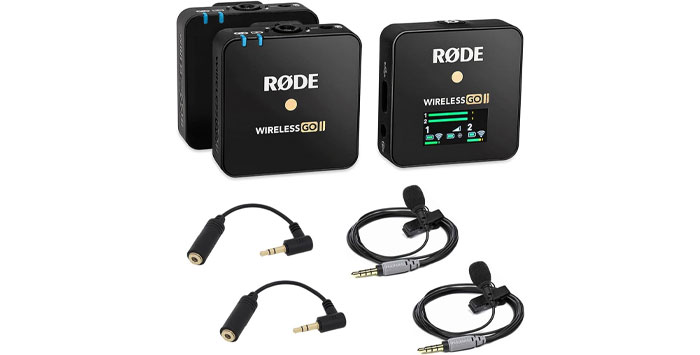
Rode has a reputation for producing great-quality sound equipment, and the Rode Wireless Go II is no exception. It’s a great piece of kit that comes through with great high quality audio.
The system comes with two microphones included, one for a host and one for a subject, and a small, lightweight receiver that can easily be either worn or mounted on other equipment such as a camera.
The microphones have omnidirectional patterns for picking up sound. The high 100dB SPL (sound pressure level) means that it can record loud noises without distortion while having a wide enough frequency response range to capture quiet sounds too.
There’s also a 200m transmission range between the mic and the receiver so you can confidently record some distance from your subject.
Overall, the Rode Wireless Go II is a fantastic wireless lavalier microphone and a great starting place.

Shure is another name synonymous with great-quality audio products and the BLX14 is a worthy addition to anyone’s microphone set-up.
The BLX lavalier microphone comes with a fantastic transmission range of up to 300 feet and replaceable AA batteries mean you don’t have to be constantly looking for a charger to keep things on the go – just swap them out and you’re back in business. 2 AA batteries provide up to 14 hours of battery life though, which should be more than enough for most people.
The design of the lav mic itself is discreet, small, and sturdy, and it uses a cardioid pattern to reduce the amount of background noise captured. There’s also RF (radio frequency) filtering to minimize any disruption from other sources such as cell phones.
The receiver is designed to be used more as a desktop device rather than some more portable solutions. This means that a nice, clear LED display helps you keep on top of your channel settings but it might limit its use in the field. However, if you are working in a studio or other similar environment then there’s no issue.
The sound quality on the BLX14 shines as you would expect from Shure. The frequency range goes from 50Hz-20KHz and the recorded audio is clear, sharp, and fully rounded.
Overall, the BLX14 is a great solution and continues to keep the Shure name associated with great audio products.
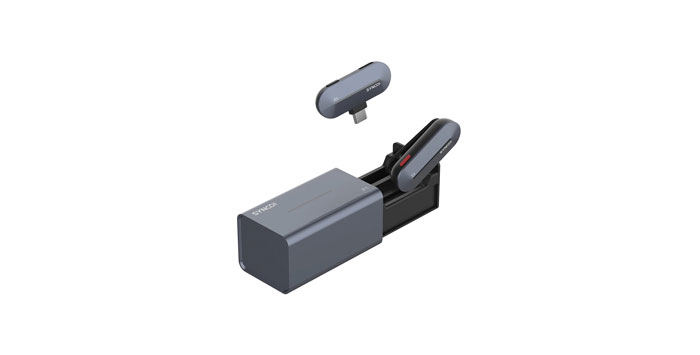
If you’re an iPhone user and looking for a lavalier mic then you could do a lot worse than the Synco P1L system.
While Synco might not be as well-known a name as some of the others on this list, they’ve produced a great product at a very affordable price. The receiver is inserted into the lightning port of your iPhone and comes with a charging case so it can recharge while not in use. The receiver has a 5-hour charge and has a range of nearly 500 feet, which is remarkable.
Sound quality is also excellent and the audio it records is crisp and clear with background noise kept to a minimum and features a cardioid pattern to keep unwanted sounds out of your recording.
The receiver is lightweight and has a 3.5mm jack for direct monitoring. It even comes in a couple of different colors, should the aesthetics of it also be of concern to you!
The P1L system is a powerful little device — great audio quality, a compact design, and a great price point. There’s a lot to love here!
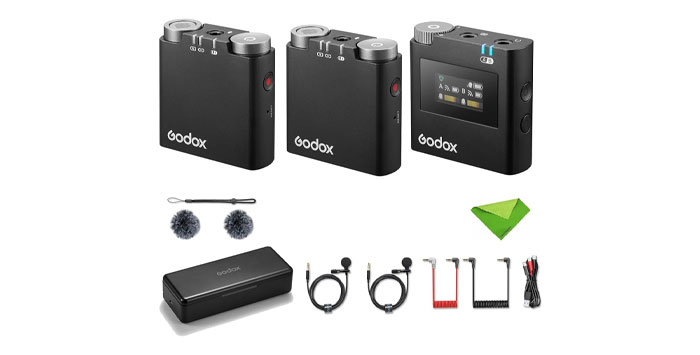
If you’re looking for top-quality audio performance and a great lavalier microphone solution then the Godox Virso M2 is another excellent choice.
As with the Synco, Godox might not have the brand recognition of some but that hasn’t stopped them from producing a great product. The audio quality is great, and with an SPL of 110dB, you’re not going to have any distortion issues when capturing loud noises.
Sound quality is clear and distinctive, and full-quality sound is picked up by an omnidirectional polar pattern. It’s also a great choice for beginners, as it’s designed very much as a plug-and-play system. There’s no complex setup, drivers, or any other issues to get in the way of your recording — just fire it up, plug it in, and you’re good to go.
While the Godox can be used with any system, it also comes with a hot shoe adapter which is specifically designed for a Sony camera to improve signal quality over traditional 3.5mm jacks. However, even if you don’t have a Sony camera and do use a 3.5mm jack, the sound quality is still fantastic.
And you get plenty of kit for your money, including windshields, cables, two lavalier microphones, and connecting cables. And as recording is done on MicroSD cards, you can always expand its capacity.
While the Godox isn’t quite the cheapest lavalier microphone on the list, you get plenty for your money compared to some bare-bones offerings. The sound quality alone makes this a real contender.

If you’re looking for a compact solution and size is a premium to you, then the Boya BY-XM6-S2 is a great little solution. Portability is very much the name of the game.
The BY-XM6-S2’s compact design makes it ideal for bloggers out in the field; this is a lavalier microphone setup that benefits from being taken out and about.
Set-up is quick and easy and everything just works straight out of the box so there’s minimal hassle when you need to get recording in a hurry — even the wireless transmitter and receiver come pre-paired.
The receiver comes with a built-in 3.5mm headphone jack for direct monitoring and zero latency. The range of 300ft is more than acceptable for most uses. And with a seven-hour charge, you should be able to capture everything you need to and then some.
The quality of the audio is exactly what you would hope for — clear, clean, and sharp. There’s the option to record in mono or stereo (a surprisingly rare option and much appreciated) and sound is captured via an omnidirectional polar pattern.
There’s also an on-device display screen which is clear and easy to read. This makes for a refreshing change from other devices that need apps or base systems to figure out what’s going on with your set-up.
There’s really very little to complain about here. Great compact design, plenty of goodies that come with it (including foam and fur windshields to cut down wind noise), and excellent sound quality — this is a versatile lavalier microphone!

Lavalier microphones can often be specific to one particular use case, but if you’re looking for one equally at home being used for interviews as well as vlogging, then the DJI Mic is a good shout.
It’s a small, light, and portable solution, so taking it out into the field is simple and pain-free while using it in a studio environment means that the equipment is discreet and easy to keep out of the way.
The build quality is great too, so it will be able to survive a few bangs and knocks when you’re out and about. And there’s a magnetic clip design if you don’t want clothing to get rumpled by a more conventional type of plastic clip.
There’s impressive battery life on show here too, with around five-and-a-half hours of charge in the internet battery which rises to 15 hours with the provided charging case. The range is a ridiculously huge 820 feet and the receiver features an on-device display and touchscreen to help you keep on top of what’s going on with your equipment.
The sound quality is high, even over distances, and an omnidirectional pattern is used for the mics. If you’re looking for a solidly-built, high-quality microphone that can be used flexibly then the DJI Mic is worth checking in on.

A budget price doesn’t always budget quality, so to finish up we have the very affordable Hollyland Lark M1. This colorful set-up might be relatively cheap, but that doesn’t mean it sacrifices cost for sound quality.
This is an omnidirectional lavalier microphone, with a good frequency response range of 20Hz-20Khz, which is pretty impressive for such a cheap unit. And a battery life of eight hours is similarly impressive so you should be able to keep yourself on the go however long you’re recording for.
The transmission distance impresses too, at up to 650 feet, and there’s built-in noise cancellation as well — a real bonus at this price point.
Sound quality is good and the two microphones that come with it are responsive and produce clear audio.
This is a budget solution so certain elements are missing. There’s no on-screen displays, and power is indicated by a simple, four-LED display on the charging case.
Saying that, the device does come with windscreens to keep wind noise at bay and additional cabling, so it’s not a complete bare-bones purchase. However, you will be unsurprised to discover at this point that there’s no lightning converter for Apple users.
Inexpensive it might be, but the Hollyland Lark M1 is still a great device and a great choice, especially for newcomers.

As with any piece of recording equipment, there are both pros and cons to using wireless mics.
The most obvious point is the fact that because wireless lavalier mics are wireless they require power and depending on your set-up this might not always be the most convenient set-up. Wireless has the advantage of being able to move, walk around, drive, or any other scenario where mobility is a premium and you can do it without being encumbered by cabling.
On the other hand, if you have a cabled solution then you never need to worry about a red flashing light indicating your battery is about to run out. If you are planning on long recording sessions then a cabled solution may be more appropriate.
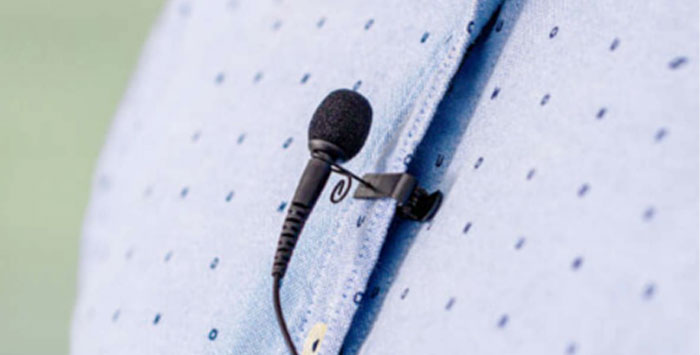
Because lavalier microphones are, by their very nature, small this means that they can also be fragile. Especially at the less expensive end of the market, cheap plastic construction can mean that there’s not a lot of durability. More expensive lavalier microphones can (and do) overcome this but they come at a premium.
Wired microphones can also suffer from durability issues but often less so. While the quality of wireless lavalier microphones is always improving, if you need a hardy, solid solution then a wired one might be the way to go.

Because wireless microphones use radio frequencies to broadcast their signal it means that this signal can suffer from interference. Many wireless lavalier microphones will specify “line of sight” transmission because objects such as walls, glass, etc can cause the range of a transmitter to fall dramatically or otherwise cause interference that might result in less good sound quality.
Wired solutions don’t have this issue — a wired microphone will plug directly into the recording device and a good-quality wired microphone will be shielded against RF (radio frequency) interference to ensure clarity of signal.
Saying that, if a wireless lavalier mic is operating over a fairly small distance — say around 65 feet, which should most scenarios — the chances of interference causing you problems are relatively slight, even if you are out in the field. It’s only over longer distances that this might become an issue.
However, if you do need to record over a long distance, cabling for a wired solution becomes a whole new problem!
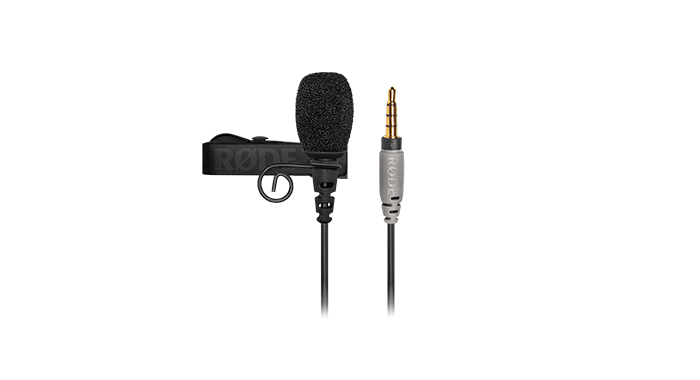
There are a few ways to choose a lavalier microphone to ensure you get what you want from your recording.
Cost is self-explanatory and you should buy a microphone that fits your budget that will also provide you with the equipment you need.
While a wireless lavalier microphone are often more expensive than wired lavalier mics they do come with a range of advantages. Make sure you buy a lavalier microphone that suits your wallet as well as your needs.
The big one. If you’re going to be shelling out for a wireless set-up you want to know that you’re getting the best quality sound possible. Few things turn off listeners more than bad quality sound, and ensuring you pick a lavalier microphone that captures crystal-clear audio is an absolute must.
Sound quality is related to the type of polar pattern the microphone uses. Omnidirectional polar patterns capture everything around the microphone. This is great if you want to capture the ambiance of a location but less good if you want to only hear your subject.
Cardioid patterns are directional, so help to keep background noise to a minimum and require that the microphone is pointed at the subject. Which one you need will depend on exactly what you want to achieve with your recording.
Related to this is what you’re going to use the wireless lavalier microphone for. If you’re in a quiet studio environment where you need to capture nothing but the audio of your subject — a podcast, for example, or audio drama — then your needs are likely to be very different than if you are out on the street conducting vox pops or interviewing people in situ.
Choosing the lavalier mic you need will be strongly dependent on how you are going to deploy it. There’s no point in investing in (and paying for!) a wireless system that can cover hundreds of feet in transmission range if your subjects are never going to be more than a few feet apart.
Similarly, if you are going to be out and about, don’t invest in something better suited to an indoor environment.

Wireless lavalier microphones are a great solution for anyone looking to record audio. They provide flexibility and allow for a whole range of uses where a traditional wired might not be appropriate or suitable.
And despite the wide range of devices and quality available it’s possible to narrow this down to the very best on the market. So decide what you want to do, how much you can spend, and get buying!